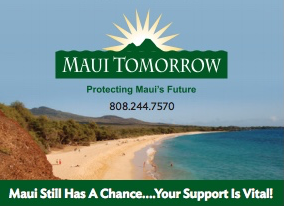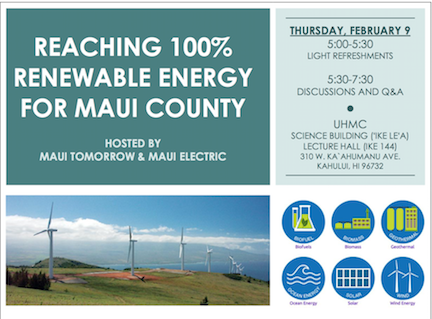Friday, January 14, 2011
By Henry Curtis
Life of the Land
The Big Wind hearing filled the Senate Conference Room, and the overflow room overflowed. Some people milled around in the hall, others left.
Big Wind refers to the concept of building an interisland undersea high voltage electric transmission line between Moloka`i, Lana`i and/or Mau`i to O`ahu so that ever energy hungry O`ahu can be fed by the Neighbor Islands.
Giant wind farms would be built in Mau`i County. Each tower would be as tall as the First Hawaiian Bank in downtown Honolulu. Perhaps 200 of them would industrialize the rural areas of Moloka`i and Lana`i.
There are currently no interisland electric lines in Hawai`i.
Except for the failed attempt to bring geothermal energy to O`ahu in the 1980s, no one in the State has ever proposed building 400MW of electrical generators in one shot.
The cost of the interisland cable would be $600M to $1B. According to HECO the cost to upgrade the O`ahu grid to handle Big Wind would be at least $300M.
The wind farms would cost up to $1B.
Steve Lindenberg, representing the United States Department of Energy, stated at the hearing that “ultimately the summary is, this looks like it could be affordable.” He noted that all permits would be completed and the project would be ready to be built in 2020. “And so it is a long way off that you saw, it’s 2020 or something like that, it might be we’ll get lucky and we’ll move into the teens to be able to have a project ready to go if it’s appropriate to do that. But it is a lot of work from here on out.”
At the hearing HECO presented a power point slide with a title “Oahu Energy Price Comparison.”
The power point compared the prices of various types of generation. I found this puzzling because all prices that the utility pays for electricity from non-utility generators are “Confidential Business Information” (CBI). In regulatory proceedings those wishing to see the data have had to sign Protective Orders agreeing not to share the data. So what become public?
To understand the data shown one had to look at what the x-axis and y-axis were comparing.
The x-axis was titled “Energy Source.” One energy source listed was HECO generation. HECO generators run on both biofuel and fossil fuel. Thus the base case is a snapshot at one point in time of an ever changing mix of fossil fuel and biofuel.
The y-axis measured “Marginal Cost ($/kWh).” HECO contracts are based not on marginal costs but on average costs.
What is relevant for comparison is not the cost of baseline generation today and renewable generation of the future (2015-20), but rather what the trend line says the costs will be for each type of generation in the same year, or averaged over an identical period of time.
In 2020 the HECO contracts for fossil fuel from non-utilities will have expired. Currently there are no plans to renew them.
HECO will be switching from fossil fuel to biofuels for its own generators. Biofuels currently cost more than fossil fuels. Therefore all of the lower cost items on the graph will have disappeared.
The Lana`i wind farm was quoted at 21 cents /kWh ($0.13 for Lana`i production and $0.08 for interisland cable). The interisland cable has been quoted at $600M – $1B. The O`ahu upgrades have been quoted at $300M and up. Only the cable and Lana`i estimates were used in the price comparison, not the total cost of the project including the O`ahu upgrades.
The Environmental Impact Statement Preparation Notice (EISPN) was released last month. The comment period goes to March 1. There is no cost ($/kwh) information in that document.
The Public Utilities Commission (PUC) will need to approve this project. If the Lana`i and Moloka`i windfarms cost ratepayers different amounts, is it in the public interest to do both or, if anything is built, is it better to double the size of the cheaper one?
The hearing was held by Senators Mike Gabbard and Rosalyn H. Baker, who listened politely to the nine presentations. Senator Kalani English joined them for the question and answer phase of the hearing.
Presentations were made by (1) DBEDT; (2) HECO; (3) Castle & Cooke; (4) First Wind; (5) Lanaians for Sensible Growth; (6) Friends of Lana`i; (7) Hui Ho’opakele Aina (Moloka`i); (8) Moloka‘i Community Service Council; and (9) the U.S. Department of Energy.
First Wind informed Legislators that they will build their windfarm on Moloka`i or other islands. They would prefer Moloka`i but right now they don’t have control over any land. According to DBEDT, if the windfarm is built on Mau`i, then the cable would go to Mau`i. If it is going to Mau`i for wind could it also acquire geothermal electricity? Why not?
Steve Lindenberg’s job includes coordinating US DOE efforts to expand geothermal across the United States. On January 27, 2010, the US DOE awarded Ormat Technologies, Inc $4,911,330.00 in Stimulus Funds to explore for geothermal on Mau`i.
Four years earlier, Global Energy Concepts, LLC wrote a report for DBEDT and DLNR which stated that Mau`i has 139MW of geothermal resources split roughly 50-50 between the Haleakala Southwest Rift Zone and the Haleakala East Rift Zone.
Steve Lindenberg told the Senators: “You have a rich group of resources on these islands, amazingly rich …All options are going to have to be considered. …geothermal has the problem of not being in the right place.”
Senator Baker asked Steve Lindenberg: “I know most of the EIS process that were accustomed to, doesn’t just look at one alternative, and there has been some discussion about well wind is better and we don’t know about wave we don’t know about these other things, but the wind farm is going to have such lasting impacts on some very small communities that it makes me wonder why we’re not looking at other things and including that in the programmatic EIS rather than just wind or nothing. So can you please shed some light on that?”
Steve Lindenberg replied: “You’re absolutely correct, there is a requirement that there is a series of alternatives that must be considered and they, first, have already been analyzed at some depth, before we got to this point, but we will be considering and documenting that evaluation further, in the ultimate product that we will put out for the programmatic EIS. And so there are reports and documents that we’ve done.”
In other words, since we are doing Big Wind, and since Mau`i geothermal would compete against it we have dismissed it as a viable option.
Ormat, in applying for the Stimulus Funds, stated: “Guided by lessons learned at Puna, the exploration toolset will then be applied at Ulupalakua Ranch on Maui to define a viable geothermal resource.”
Moloka`i and Lana`i could produce 400MW of peak wind power (available during windy conditions). The average wind output would be 40% of 400MW or 160MW. The geothermal would be available 100% of the time. Thus the wind would produce slightly more than the geothermal (139MW), but the geothermal could offset demand during the peak usage period, something wind can’t do.
Steve Lindenberg told the Senators: “I have been …here on island for about 7 months.”
Governor Lingle announced Steve Lindenberg’s arrival to Hawai`i in an August 5, 2010 press release. “He will work directly with the Department of Business, Economic Development and Tourism’s State Energy Office and play an important role in guiding the Hawai‘i Clean Energy Initiative (HCEI).”
Since his arrival he has been a frequent speaker at events including the Asia Pacific Clean Energy Summit and Expo held at the Hawaii Convention Center (August 30 – September 2, 2010), the World Congress on Zero Emissions Initiatives held also at the Hawai’i Convention Center (September 13-17, 2010), the 2010 Hawai’i Agriculture Conference (September 23-25 2010) held at Ko Olina, and as a guest speaker at the UH Manoa Civil and Environmental Engineering Seminar series (October 7, 2010).
Steve Lindenberg told the crowd at the Senate hearing: “You have a rich group of resources on these islands amazingly rich …How can we get to a point where we have a full portfolio of energy options that you can look to? …All options are going to have to be considered. …
It’s the portfolio option, it’s not the single project, it’s not the single technology, it’s not the silver bullet. We have to look at all these things to be able to move forward. … solar is a challenge …geothermal has the problem of not being in the right place, wave hasn’t developed yet …OTEC is some years off …so wind is an option that needs to be very seriously looked at. …
We have to scope the process, we have to do the work, and we will get to a point perhaps 18 months from now perhaps, of having prepared a Programmatic EIS, gone thru a comment period, and come to some point of conclusion about that.
Then there will have to be specific EIS activities and permitting processes undertaken for each of these projects, and those will be another year, year and a half, two years.
And so it is a long way off that you saw, it’s 2020 or something like that, it might be we’ll get lucky and we’ll move into the teens to be able to have a project ready to go if it’s appropriate to do that. But it is a lot of work from here on out. …
Ultimately the summary is, this looks like it could be affordable. …
We’ve taken as an example a look at trying to put solar on that aspect of each roof in the island of O`ahu and putting up, some large pv [photovoltaic] arrays and solar thermal arrays, and we get about half of what we get out of the wind process and its substantially more expensive.”
Senator Baker: “Are those studies and analysis public?”
Steve Lindenberg: “They have been discussed with a number of organizations they will be put into a public presentation and as we get them into the EIS so we have had conversations about this at the Hawaii Clean Energy Initiative’s Working Groups and Steering Committees, we’ve worked with various organizations to talk through these issues we’ve not put them out as a final report at this point.”
Senator Baker: “When can we anticipate that that report will be available so people can have a chance to take a look at it?”
Steve Lindenberg: “Ah, during this time that we will be doing this review of the EIS, probably in the February or March time frame we will be putting out the initial reports on that.”
Senator Baker: “It’s my understanding that there was a study that looked at various electrical rates, various scenarios maybe one would call it a variable rate analysis, I think Booz Allen may have done the study. Is that study on a web site so people can take a look at it. The reason I’m asking these questions is because I’m of the opinion that the more information everybody has and has available we take the mystery out …that people that have a better opportunity to make their own evaluations about what’s being proposed and whether it’s something they can live with or not. …So we can expect it in February or March?”
Steve Lindenberg: “Yes.”


